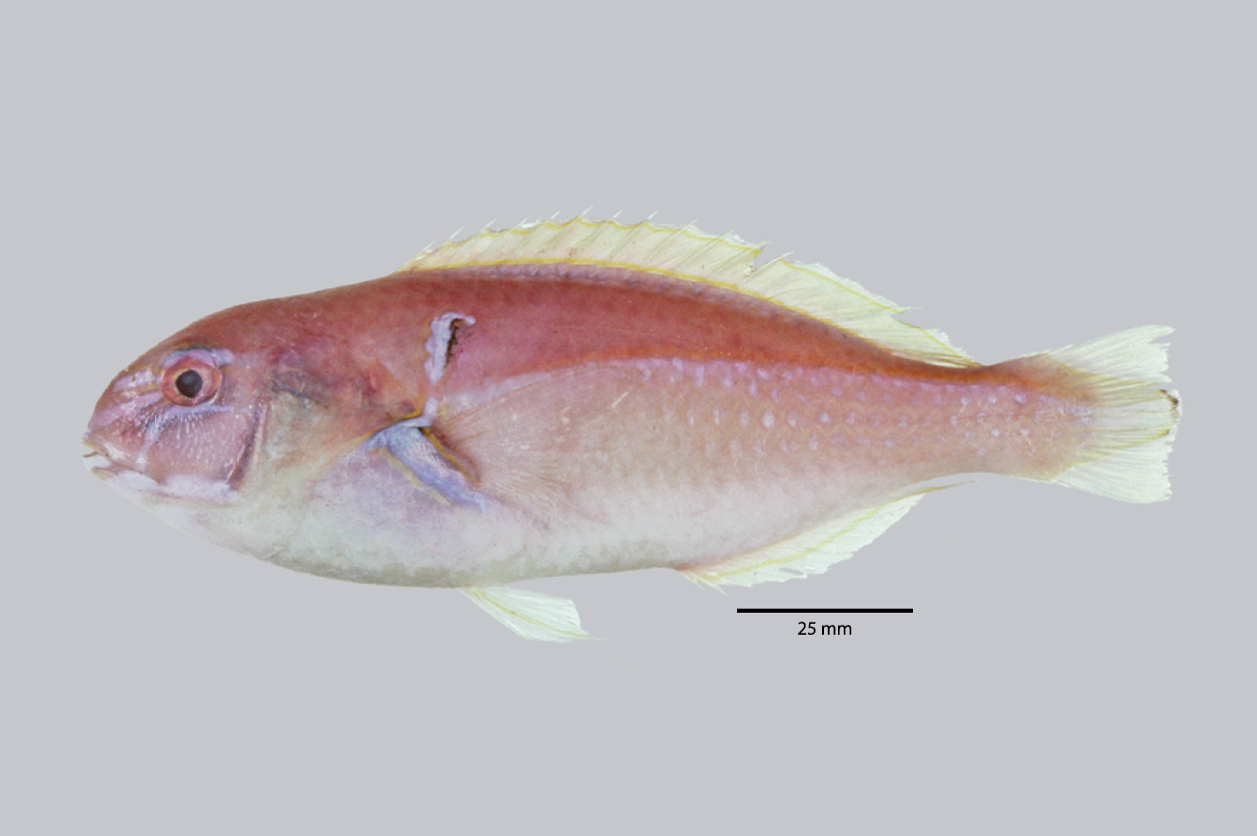- Classification
- ACTINOPTERYGII
- PERCIFORMES
- LABRIDAE
- Choerodon
- sugillatum
Wedgetail Tuskfish, Choerodon sugillatum Gomon 1987
Other Names: Wedge-tailed Tuskfish

A terminal phase (male) Wedgetail Tuskfish, Choerodon sugillatum, from Pollard Channel, Great Barrier Reef, Queensland, CSIRO H.3897-04, 135 mm SL. Source: T. Carter / Australian National Fish Collection, CSIRO. License: All rights reserved
Summary:
A small tuskfish with a prominent black and blue, slash-like mark on the upper side above and behind the pectoral-fin base in males. Females and juveniles also have an orange mid-lateral stripe, and the slash-like mark is smaller and more rounded. The upper corner of the pectoral fin is rather pointed, and the lower ray is elongated, giving hind margin of the fin a lunate appearance.
Cite this page as:
Bray, D.J. 2021, Choerodon sugillatum in Fishes of Australia, accessed 06 Jul 2025, https://fishesofaustralia.net.au/home/species/2966
Wedgetail Tuskfish, Choerodon sugillatum Gomon 1987
More Info
|
Distribution |
Endemic to northern Australia from the Dampier Archipelago, Western Australia, to the southern Great Barrier Reef, Queensland. Inhabits flat sandy, seagrass or macroalgae areas at depths of about 5-85 m. |
|
Features |
Dorsal fin XII, 8; Anal fin 111, 10; Pectoral fin ii, 13-14; Lateral-line scales 27 + 2; Predorsal scales 5-7; Scales above lateral line 3-3 1/2. Body and head shallow, becoming moderately deep in large adults, body depth 26.6-37.1%SL. Eye large. Predorsal scales reaching forward to above midpoint between hind margin of eye and hind edge of preopercle. Cheek scales reaching forward to below anterior extent of orbit; moderately narrow naked margin along free edge of preopercle; subopercle with 5-9 uniserial scales reaching forward to below centre of eye. Lateral-line scales usually without accessory branches associated with sensory pore. Upper jaw with two pairs of prominent ventrally directed canines anteriorly, anteriormost about twice the size of second; upper jaw without posterior canines. Lower jaw with two pairs of prominent anterior canines, anteriormost much smaller than second; second pair strongly curved laterally. Caudal fin broadly wedge-shaped, upper and lower corners each produced into slight lobe. Pectoral fin rather pointed dorsoposteriorly, with lower ray produced, giving hind margin of fin lunate appearance. |
|
Colour |
Juveniles pale with narrow dusky midlateral stripe on sides extending from opercular margin onto caudal fin; small triangular dark mark extending from lateral stripe above pectoral-fin base toward lateral line. Initial and terminal phase individuals pale with hazy angled dark slash on side about midway between pectoral-fin base and dorsal profile of side; small dark spot at upper end of pectoral-fin base and short narrow dark mark near centre of hind margin of caudal-fin. |
|
Fisheries |
Wedgetail Tuskfish is regularly taken as bycatch in the prawn trawl fishery. |
|
Etymology |
The specific name is from the Latin sugillatum (= black and blue spot), in reference to the characteristic marking on the side of this species. |
|
Species Citation |
Choerodon sugillatum Gomon 1987. Mem. Mus. Vic. 48(1): 19. Type locality: Cape Bedford, Queensland. |
|
Author |
Bray, D.J. 2021 |
|
Resources |
Wedgetail Tuskfish, Choerodon sugillatum Gomon 1987
References
Allen, G.R. 1997. Marine Fishes of Tropical Australia and South-east Asia. Perth : Western Australian Museum 292 pp. 106 pls.
Allen, G.R. & Randall, J.E. 2002. A new species of wrasse (Labridae: Choerodon) from the tropical western Pacific. Aqua, Journal of Ichthyology and Aquatic Biology 5(3): 109-113.
Allen, G.R. & Swainston, R. 1988. The Marine Fishes of North-Western Australia. A field guide for anglers and divers. Perth, WA : Western Australian Museum vi 201 pp., 70 pls.
Blaber, S.J.M., Brewer, D.T. & Harris, A.N. 1994. Distribution, biomass and community structure of demersal fishes of the Gulf of Carpentaria, Australia. Australian Journal of Marine and Freshwater Research 45(3): 375-396
Cheung, W.W.L., Pollard, D. & Liu, M. 2010. Choerodon sugillatum. The IUCN Red List of Threatened Species. Version 2015.2.
Gloerfelt-Tarp, T. & Kailola, P.J. 1984. Trawled Fishes of Southern Indonesia and Northwest Australia. Jakarta : Dir. Gen. Fish. (Indonesia), German Tech. Coop., Aust. Dev. Ass. Bur. 406 pp.



